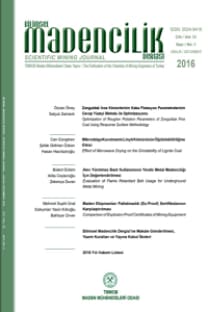Zayıf zeminlerde açılan büyük çaplı çift tüp tünellerde tünellerin birbirine olan etkisinin 3 boyutlu sayısal analizler ile incelenmesine bir örnek, Bolu Tüneli destek sistemlerinin değerlendirilmesi
An analysis of interaction between large diameter double tube tunnels excavated in weak soils through 3D numerical analysis; An example of Bolu Tunnel
___
- Aygar, E. B. 2000. Yeni Avusturya tünelcilik yöntemine eleştirel bir yak- laşım. [master tezi]. [Ankara]:Hacettepe University
- Aygar, E.B. 2007. Bolu Tüneli duraylılığının satik ve dinamik analiz yöntemleriyle incelenmesi. [doktara tezi]. [Ankara]: Hacettepe University.
- Aygar, E.B. 2020. Evaluation of new austrian tunnelling method app- lied to bolu tunnel’s weak rocks. Journal of Rock Mechanics and Geotechnical Engineering 12 (2020) 541-556.
- Aygar, E.B. 2021a. An evaluation on causes behind the bolu tunnel col- lapse following the 12 November 2 1999 düzce earthquake: se- ismic action or inadequate tunnel support capacity, in Reviewer.
- Aygar, E.B. 2021b. An assessment on problems encountered during tunneling in graphitic schists, in Reviewer.
- Aygar, E.B., Gokceoglu, C. 2020. Problems encountered during a ra- ilway tunnel excavation in squeezing and swelling materials and possible engineering measures: a Case study from turkey. Sustai- nability. 12, 1166, https://doi.org/10.3390/su12031166.
- Aygar, E.B. Gokceoglu C. 2021a. Evaluation of collapsed zone in t24 tunnel (ankara-istanbul high speed railway project, turkey). Euro- engeo. 3rd European Regional Conference of IAEG.
- Aygar, E.B., Gokceoglu, C. 2021b. A special support design for a lar- ge-span tunnel crossing an activefault (t9 tunnel, ankara–sivas hi- gh-speed railway project, turkey). Environmental Earth Sciences, 80 (1), 37, https://doi.org/10.1007/s12665-020-09328-1.
- Aygar, E.B., Gokceoglu, C. 2021c. Analytical solutions and 3d numeri- cal analyses of a shallow tunnel excavated in weak ground: a case from turkey. International Journal of Geo-Engineering. 12 (1), 9, DOI: 10.1186/s40703-021-00142-7.
- Aygar, E.B., Gokceoglu, C. 2021d. Evaluation of collapse mechanism and portal interaction of a high-speed railway tunnel (t29 Tunnel, turkey). Eurock 2021.Torino.
- Barla, G. 2002. Tunnelling mechanics tunnelling under squeezing rock conditions tunnelling mechanics - advances in geotechnical engi- neering and tunnelling (pp.169-268) chapter: 3 publisher: P.O.Box 1675 Editors: D. Kolymbas.
- Barla, G. 2016. Full-face excavation of large tunnels in difficult condi- tions. Journal of Rock Mechanics and Geotechnical Engineering, (2016) 294-303.
- Dalgıç, S. 2002. Tunneling in squeezing rock, the bolu tunnel, anatolian motorway. turkey. Engineering Geology.
- Geoconsult ZT GmbH. 1998. Bolu tunnel geological longitudinal pro- file along left tube as built conditions, asarsuyu portal to elmalık portal.
- Geoconsult ZT GmbH. 2002. Anatolian motorway stretch-2 bolu tun- nel by-pass rock support class distribuiton.
- Goel, R.K., Jethwa, J.L., Paithakan, A.G. 1995. Tunnelling through the young Himalayas – a case history of the Maneri-Uttarkashi power tunnel. Engrg. Geol., 39, pp. 31-44.
- Hoek, E. 2001. Big tunnels in bad rock, The 36th Karl Terzaghi lecture. Journal of Geotechnical and Geo-environmental Engineering, A.S. C.E., 127(9), 726-740.
- Hoek, E. 2007. Practical Rock Engineering, p 341, https://www.rocs- cience.com/assets/resources/learning/ hoek/Practical-Rock-En- gineering-Full-Text.pdf.
- Hoek, E. 2012. Rock Support Interaction analysis for tunnels in weak rcok masses, https://www.rocscience.com/documents/pdfs/ro- cnews/winter2012/Rock-Support-Interaction-Analysis-for-Tun- nels-Hoek.pdf.
- Hoek, E., Marinos, P. 2000. Predicting tunnel squeezing. Tunnels and Tunnelling International. Part 1 – November 2000, Part 2. Itasca, 2002. Flac3d User Manual Getting Started.
- Jethwa, J. L. 1981. Evaluation of rock pressures in tunnels through squ- eezing ground in lower himalayas. PhD thesis.Department of Civil Engineering. University of Roorkee,India, 272.
- KGM (General Directorate of Highways). 2013. Technical specifications of general directorate of highways.
- Lettis, W. & Asssociates Inc., A.Barka, 2000. Geologic Characterisati- on of Fault Rupture Hazard, Gümüşova-Gerede Motorway project report.
- Lunardi, P. 2000a. The underground as a resource and reserve for new spaces; adec-rs as an effective tool to be able to realize them (part 1). Proceedings of the Bindi R, Cassani G World Tunnel Congress 2014 – Tunnels for a better Life. Foz do Iguaçu, Brazil.
- Lunardi, P. 2000b. The underground as a resource and reserve for new spaces; adeco-rs as an effective tool to be able to realize them (part 2). Proceedings of the Bindi R, Cassani G World Tunnel Congress 2014 – Tunnels for a better Life. Foz do Iguaçu, Brazil.
- Lunardi, P. 2008. Design and construction of tunnels, analysis of cont- rolled deformation in rocks and soils (adeco-rs). 587 p.
- Lunardi, P. 2014. The design and construction of tunnels using the ap- proach based on the analysis of controlled deformation in rocks and soils. T&T Interneational ADECO-RS Approach, www.rocksoil.com.
- Lunardi, P. 2016. Evolution of design and construction approaches in the field of tunnelling: the results of applying ADECO-RS when constructing large underground works in urban areas. Procedia Engineering, 165, 484 – 496.
- Rabcewicz, L. 1964a.The new austrian tunnelling method, part one. Water Power. 453–7.
- Rabcewicz, L. 1964b. The new austrian tunnelling method, part two. Water Power 1964b; 511–5.
- Rabcewicz L. 1965. The new austrian tunnelling method, part three. Water Power 1965; 19–24.
- Rabcewicz, L, Golser J. 1973. Principles of dimensioning the sup- porting system for the “new austrian tunnelling method”. Water Power, Marc, 88-93.
- Sakurai, S. 1983. Displacement measurements associated with the design of underground openings. Proc. Int. Symp. Field Measure- ments in Geomechanics, Zurich 2, 1163-1178.
- Schubert, W. 1996. Dealing with squeezing conditions in Alpine tun- nels.” Rock Mech. Rock Engng. 29(3), 145-153.
- Singh, B., J, L., Jethwa, A. R., Dube, B., Singh. 1992. Correlation between observed support pressure and rock massquality.” Tunnelling and Underground Space Technology. 7(1).
- ISSN: 2564-7024
- Yayın Aralığı: 4
- Yayıncı: TMMOB Maden Mühendisleri Odası
Kritik Hammaddelerin Geri Dönüşüm ile Döngüsel Ekonomiye Kazandırılması
Ata AKÇIL, Ceren ERÜST ÜNAL, Mediha Demet OKUDAN ALTINDAŞ
Sedanur BAŞ, Taki GÜLER, Selçuk AKTÜRK
Dredging Technology of Placer Deposits in the Far North
Ravil Zinnurovich NAFİKOV, Victor Evgenievich KİSLYAKOV, Aleksandr Konstantinovich KİRSANOV, Ekaterina Vasilevna SHEVNİNA, Anastasiya Olegovna IVANCHUK, Pavel Viktorovich KATYSHEV, Umardzhon Riezidinovich TESHAEV
TTK’DA UYGULANAN ÖN GERİLMELİ AHŞAP DOMUZDAMI SİSTEMİ
Esma Hacer EVKAYA, Erdoğan KAYMAKÇI
Turbulence models and simulation method in the CFD simulation of 75-mm hydrocyclone
